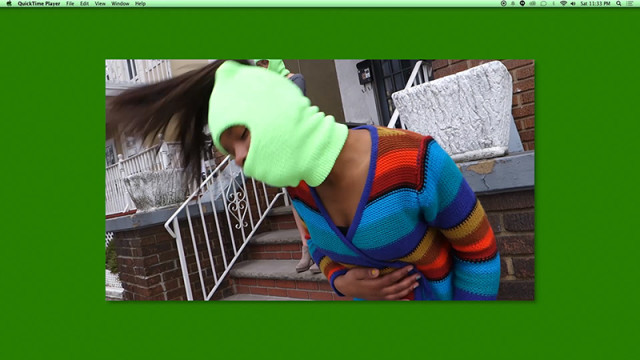It’s an overcast day in March when Sondra Perry shoots her family portrait. She gathers the roughly ten members to stand in front of what we assume is her grandmother’s house, and asks them to hold up the American flag. They are all African American and wearing neon-green ski masks. “1-2-3,” chants Perry. “Cheese!” says the family.
A finder window pops up. The cursor clicks around and starts the music. “Everybody Loves the Sunshine” rings out and the window begins to slowly rotate and float back into the neon-green desktop wallpaper.
It’s a hypnotizing and beautiful entry point into Perry’s 25-minute “Lineage for a Multiple-Monitor Workstation: Number One,” a video that uses multiple windows on dual computer screens to invite viewers and her family to reimagine black identity and social history. Perry casts her relatives as themselves, and asks them to recall and reconstruct personal and fabricated family traditions. The result is a film that presents identity as half-true, half-constructed, and entirely mutable in the digital age. It’s a brilliant video, and one of the most worthy of attention I’ve seen in a long time. (View the video in its entirety above.)
The masks are probably the most visually compelling element in the video. They carry the association of sinister criminals, as well as subversive artists like Pussy Riot. Their color matches a green screen, a special effects technique that allows filmmakers to superimpose any background on their videos. This reference suggests that it is our own projections that construct identity.
We don’t understand this metaphor immediately. The initial family portrait shows them all in masks, but in the next sequence we see Perry interviewing her grandmother about the flag out front their home. No masks are worn. Perry’s grandmother tells her she buries them in the backyard when they get old rather than burning them. Soundgarden’s “Fourth of July” plays overhead in another shot as we see the family digging up a flag and folding it as though they are giving a soldier a burial.
The point here seems not so much to be that beloved symbols need a proper burial, but that there’s no end in the process. For every flag that is buried, another just like it is hung. There are no lasting solutions. The same battles are fought over and over. As folklore has it, each fold of the flag has a different meaning, the first referring to life and the second to everlasting life.
That whole scene is fabricated, but there are few clues to let us know that—other than the detail that the family is digging up a mostly clean flag. So whereas the first scene identifies the subject matter—namely black identity and americanness‚—the next scene shows us these identities are mostly constructed. In one split-screen sequence, a screen shows her family putting on the masks and marching in a line outside their house, while on another monitor we see Perry giving stage directions to her mother, without the masks. “Just be regular” Perry tells her mother repeatedly, imploring that she not to be “too acty”. When the lines are finally delivered, Perry has not only coached her mother to sound natural, but has helped her to create a narrative in about a sweater she’s to wear to a ceremony.

I have no idea what the next scene is about, but I loved it. A trio of young women in green masks strut an imaginary catwalk in front of their house. A stately distorted male voice chants overhead “Beautiful. Gorgeous. Golden. Girl.” Horns blow. The bass gets turned up. The women move so smoothly that you forget that they have neighbors who might wonder what the hell they are doing in those masks. As a viewer, though, you’re freed of that projection. They aren’t sinister criminals, but playful subversives.
Later, Perry has her whole family peeling sweet potatoes and singing in the dining room. In one screen, none of the family is wearing the masks. Perry tells them what to do. “No talking at the table.” “Sing the song with clapping and then with no clapping.” “Try to connect, but not in a corny way.” In another screen they wear the masks, peel sweet potatoes, and say nothing. Then they break into a Gospel hymn.
Finally, Perry phones her grandmother to ask her to sing a song. A brittle, aged voice sings out, “The Guns of Brixton,” a single by The Clash that laments the heavy-handedness of the police, that led to riots. In the context of Baltimore’s Freddie Gray riots, Ferguson, Eric Garner, Walter Scott and seemingly countless other meaningless African-American deaths, the weariness of the family and her grandmother’s voice couldn’t be more apparent. How often do these battles need to be fought?
But there was more to the recitation than exhaustion— it also seemed hopeful and caring and filled with sweetness. Her grandmother wishes her goodbye by saying “I love you, MORE,” and the final words of the video hang in the air.
[This video was shown in Floating Point, a show of Columbia MFA student work I curated at Judith Charles Gallery last month.]


Comments on this entry are closed.
{ 2 trackbacks }